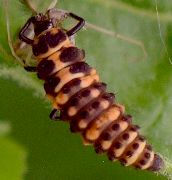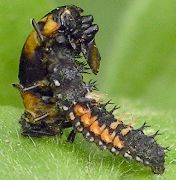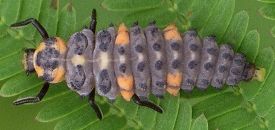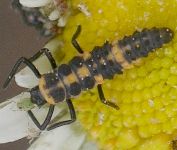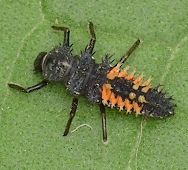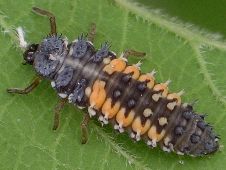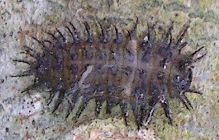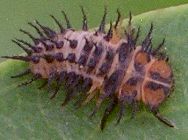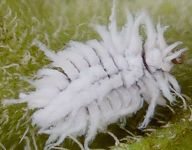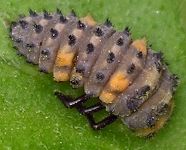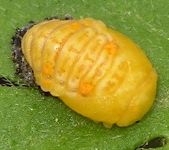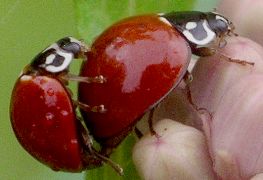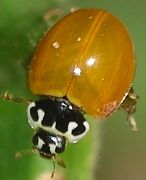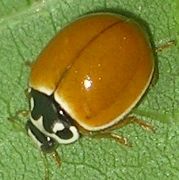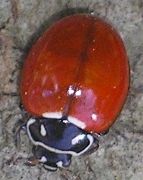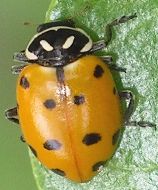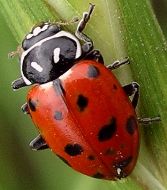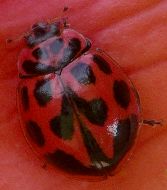
| Coccinellidae ~ Ladybird Beetles |
page 1 ![]() page 2
page 2
|
Of all the beetle families, this is perhaps the best known. Ladybird beetles (also called lady beetles and ladybugs) range from miniscule to small, with the largest being about 6 mm in length. However, they are familiar to most people because of their conspicuous habits and bright colors (the red/orange/black patterns are universal signs warning of a bad taste to predators). They also enjoy the reputation for being one of the best biological controls against insect pests in gardens.
In this family, the larvae and the adults feed on the same things and are often found together. It is relatively easy to find pupae, too. In fact, every aspect of the ladybird beetle life cycle can often be seen, from mating to ovipositing to molting to feeding, due to their numbers and preference for being out in the open on plants. While aphids are the number one food source for this mostly predatory group, they also eat scale insects, various insect eggs, a wide variety of small, soft-bodied insects, and even each other. Some species are selective, while others will eat anything they can catch. For such cute little critters, they are surprisingly voracious predators. The eggs of most ladybugs look similar: they are shaped like shiny orange or yellow spindles grouped in an irregular cluster. They may usually be found on leaves or stems, often near a colony of aphids.
The larvae of ladybird beetles have always reminded me of little orange and black alligators, with their pebbly texture and general lengthy shape. Their legs appear to end without any sort of claw or foot structures. They look like stick-figure drawings. Of course, this is not the case; the claws at the tips of the legs are just so small that they are difficult to see with the naked eye. While most of the more common ladybird beetle larvae look similar, the species have distinct color patterns, as well as different kinds of protuberances. As is common with many insects (especially caterpillars of butterflies and moths) that undergo complete metamorphosis, the larvae appear bigger than the adult (often up to about 10 mm in length), probably because they have all the cellular material that will later become wings, adult features and sexual organs contained within a simple eating machine design. The length of larvae can be about twice that of the compactly rounded adult. Some ladybird beetles have common names, while others do not. As expected, the most easily noticed are more likely to have these familiar monikers. One that I find amusing is the Spotted Ladybird Beetle (Coleomegilla maculata), since the majority of these insects have spots. The larvae are distinguished by their particular orange and black pattern, and especially by the presence of two orange spots on the front part of the pronotum. Most ladybird beetle larvae keep their small head tucked down so it is barely visible, but when eating, they extend it. The younger nymph pictured here is eating some ladybird beetle eggs, which may or may not be of the same species. Both adults and larvae often dine on the eggs. More unusual dinner fare is shown in the photo of the older larva; it is eating a midge.
Ladybird beetles are not quick and agile, but will consume anything that they can overcome. One of the more graphic examples of this is illustrated in the photo of a Multi-colored Asian Ladybird Beetle larva polishing off the insides of a Seven-spotted Ladybird Beetle pupa.
The Seven-spotted Ladybird Beetle (Coccinella septempunctata) has very large and plump larvae that are mostly a dark gray color. They have four sets of orange marks on their body which set them apart from other species.
Ladybugs usually go through four stages as larvae, molting between each one. As ladybird beetles grow, they appear to inflate, so that the last instar (stage of growth) before pupation is often quite rotund. The color patterns on the body, though, remain fairly constant, but are often darker on younger larvae, becoming lighter with age.
Another very common species in our area is the Red Ladybird Beetle (Cycloneda sanguinea). The larvae of this species are very similar to some previously discussed. However, they tend to have more orange color right down the middle of their backs. In older larvae, there is a distinctive cross formed by the bands and this stripe.
The most numerous ladybug species in our area is the imported Asian Multicolored Ladybird Beetle (Harmonia axyridis). While the adults might come in a variety of colors, the larvae all look the same: dark gray with distinct orange markings. They are a large species, and are the only one of that size to have branched fleshy spines sticking out all over their body. Some ladybird beetles have more unusual looking larvae. The addition of long fleshy branched spines is a characteristic of several genera, including those in the genus Chilocorus, which specialize in eating certain species of scale insects. There are two species in our area, with adults that look quite similar. The larvae are rather different, though, with the Twice-stabbed Ladybird Beetle (Chilocorus stigma) being the more plainly colored of the two. These dark larvae often pupate in groups on the undersides of tree branches, and the old spiky skin of the larvae remains attached around the pupa, probably helping to camouflage or protect it. I've deduced that the more colorful larva, which I found only once, must be that of Chilocorus cacti, since I later found pupae and emerging adults on cactus. These pupae had distinctive light spines on the sides near the front part of the abdomen of the last larval skin. The clear white spots on the sides of the larval skin are lacking on C. stigma pupae.
Perhaps the strangest larval feature occurs on the numerous members of the genus Scymnus. These are tiny insects, with larvae only up to about 4 mm long, and they are covered with white waxy filaments that cause them to resemble mealybugs. The disguise works admirably, as I've seen these feeding on aphids that are attended by ants and the latter never even seem to notice that their wards are being decimated by the little predators. The waxy protuberances start off rather short and neatly arranged after each molt, but then grow longer and more unkempt looking before the larva molts again. It's sort of like a little white Chia pet.
If a person is ever going to witness a beetle going through its metamorphosis stages, it will probably be with a ladybird beetle. When a larva is ready to pupate, it attaches its rear end to a leaf, stem, or some other structure, and sort of rolls up. The skin splits down the back and peels towards the secured base. It usually stays there, like a little nest with the old spines sticking out. A fresh pupa is light colored, but then darkens to include black and orange markings. The sequence is shown below for a Seven-spotted Ladybird Beetle.
When ladybird beetles emerge from their pupae, they often lack some or all of their final colors. The hind wings will be sticking out from beneath the elytra (modified forewings) so that they can dry. The Seven-spotted Ladybird Beetle (Coccinella septempunctata) shown in the accompanying photo will gain its black dots and also darken to a more orange color. The freshly emerged Ashy Gray Ladybird Beetle (Olla v-nigrum) in the other photo shows only a hint of its final colors: the elytra will be black and the white spot on each will turn red!
Adult ladybird beetles are fairly easy to recognize. They are often a gold to red color, sometimes with spots. The face and pronotum frequently have black and white markings. The beetles are round and shiny, and their antennae are on the short side, with little clubs on the ends. Ladybugs are frequently on the move, as they are predators. An interesting aspect of adult ladybird beetles' feeding habits is that many species not only feed on insects but on pollen and nectar as well. In the early spring, when prey is not yet abundant, ladybird beetles of various species can be found on flowers, especially those with exposed or shallow nectaries. Our most common native member of this family is the Red Ladybird Beetle (Cycloneda sanguinea). It is a medium sized insect, very round and shiny, and has no spots on the elytra. The color ranges from orange to deep red. The white and black marks on the head and pronotum are very distinctive, and they are also gender-specific. Females and males both have white spots on the black part, but the female has black in the center, continuing down into the face, while the male has a white cleft above the head and a white face. These ladybugs are very often found feeding on aphids on milkweeds, but also occur on a number of other plants.
Another species in the same genus, Cycloneda munda, also occurs here. It is a bit smaller than C. sanguinea. The shape is usually a bit more oval than round and the color is lighter orange. The markings on the pronotum are a graceful combination of white spots on black, but sometimes the spots blend into the front white margin. It is not particularly common. I've never seen a mating pair, so I cannot confirm if the differences I've seen on their facial markings are gender specific or not. However, individuals either have a white face like the males of C. sanguinea or a black triangle in the middle of the face like the females.
There are only two species of Cycloneda reported for our area, but I occasionally find a third species, Cycloneda emarginata. The color on this one is dark orange, and the pronotum and facial markings are different from either of the more familiar Cycloneda species, with no variation in the individuals that I've seen. The size is small and the shape is more oval than round. It was rather difficult to determine the identification of this beetle, as it is not listed anywhere as being found in North America. I did find an illustration under the name of Coccinella emarginata in a reference on Central American fauna, and deduced from a couple Spanish language publications that the name had changed. The quintessential ladybug is the Convergent Ladybird Beetle (Hippodamia convergens). This is the species most often sold through gardening shops. It is not terribly common here, but shows up regularly. The shape of this species is noticeably elongate, with a pointy rear end. The color can vary from light to deep orange, and the spots can be large or absent. The pronotum markings are distinctive, with the pair of converging oval white spots that give the species its name.
A very attractive ladybug that I've only seen a couple of times is Neoharmonia venusta. This is an all-red species, with no white on the pronotum, and the black spots are consistent between individuals. It is on the larger side, at about 4-5 mm in length, and fairly rounded in shape. |
page 1 ![]() page 2
page 2
![]()


